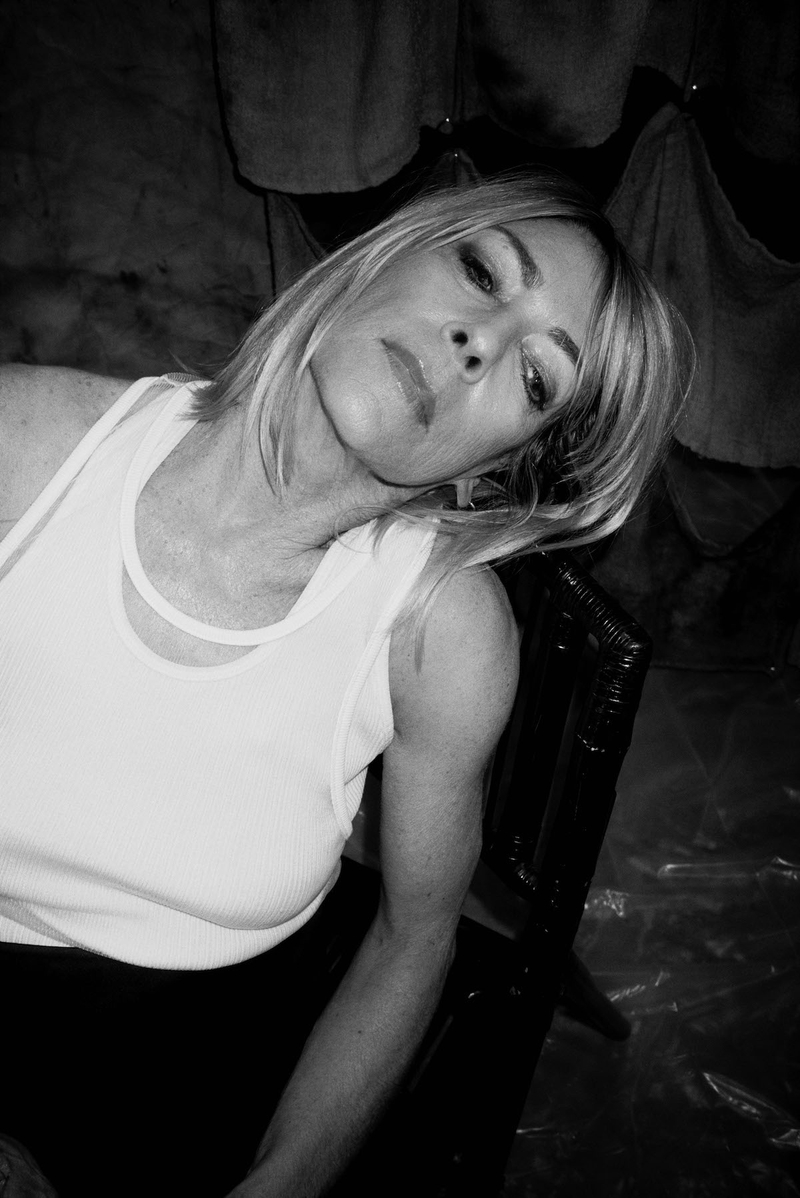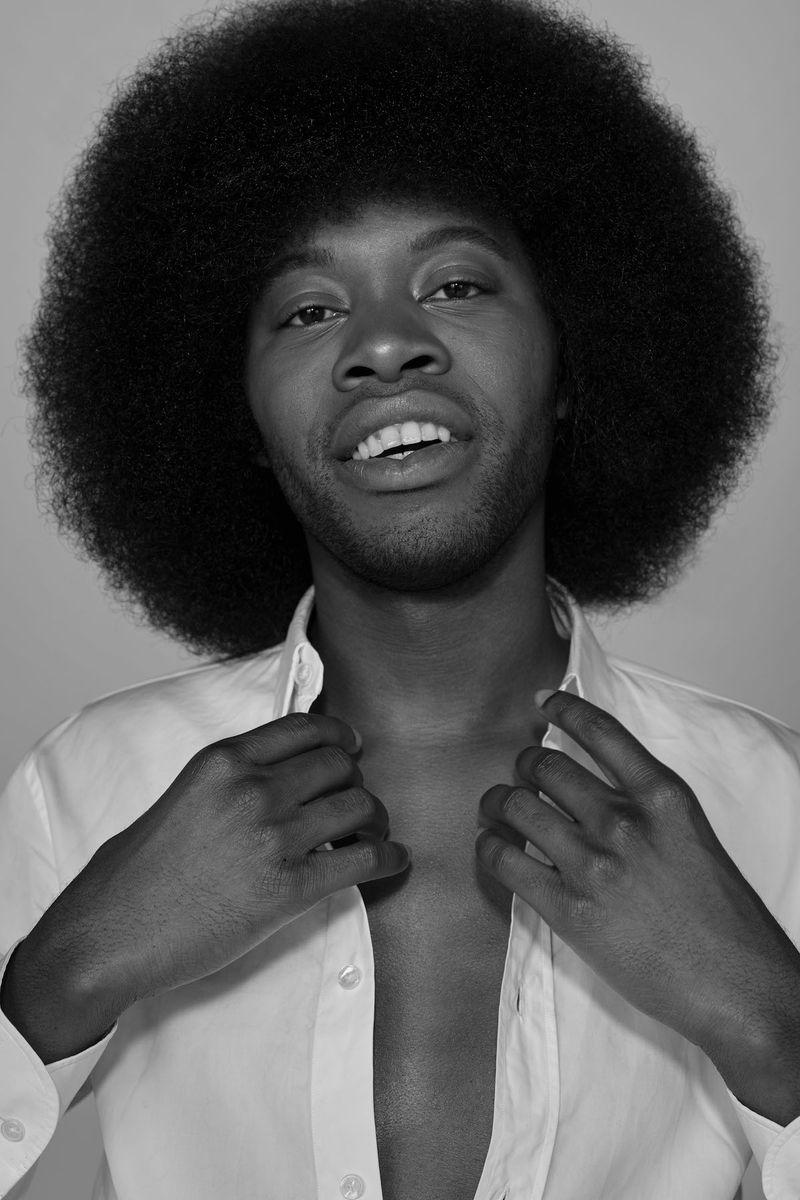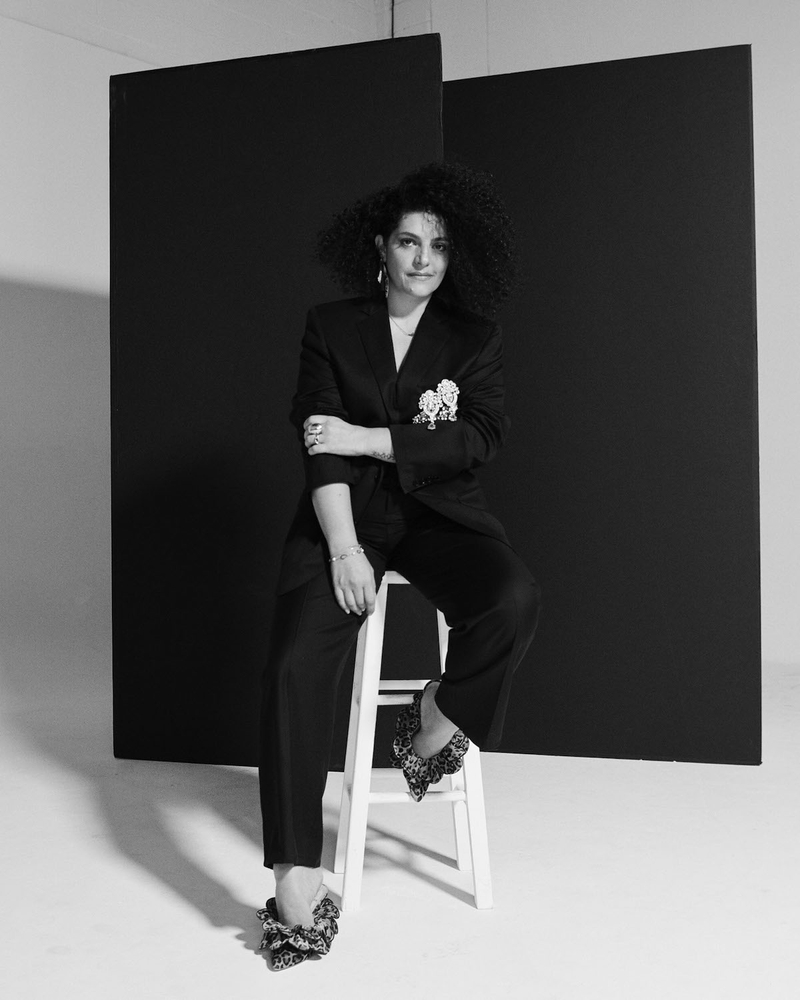The New York City in which Kim Gordon came of age no longer exists. The downtown art scene that birthed the likes of Jean-Michel Basquiat, Glenn O’Brien, and Sonic Youth—the band Gordon formed with Thurston Moore and Lee Ranaldo—has faded into myth.
The squats that used to precariously house artists have morphed into luxury lofts. The doors to the Mudd Club—the long-shuttered former hub of the scene’s counterculture where one could view works by Keith Haring, hear readings by Allen Ginsberg, or see a fashion show by Anna Sui—now lead to condos that rent for $22,000 monthly. CBGB is now a John Varvatos boutique.
But while so much of New York City’s art and culture can feel like a superficial facade of its former self, poorly disguising its corporate structure, Gordon has survived a long and storied career with her reputation largely intact. Gordon now finds herself poised to make some of the most exciting and compelling art of her career, armed with unprecedented freedom and control.
Sonic Youth is firmly in the rearview, but Gordon’s multi-disciplinary art career has never been more active. Earlier this year, she wrapped a solo show, Lo-Fi Glamour, at the Andy Warhol Museum in Pittsburgh, and when we spoke over the summer, her show She Bites Her Tender Mind was on view at the Irish Museum of Modern Art in Dublin. Her first solo album, No Home Record, produced by Justin Raisen (known for work with Charli XCX and Santigold, among others), was released October 11 via Matador. And she was just booked at SXSW 2020 in Austin, Texas, not as one of the thousands of musicians that pour into the city each year for the annual festival and conference conglomerate, but as a keynote speaker —a testament to her wealth of experience and the value of her perspective.
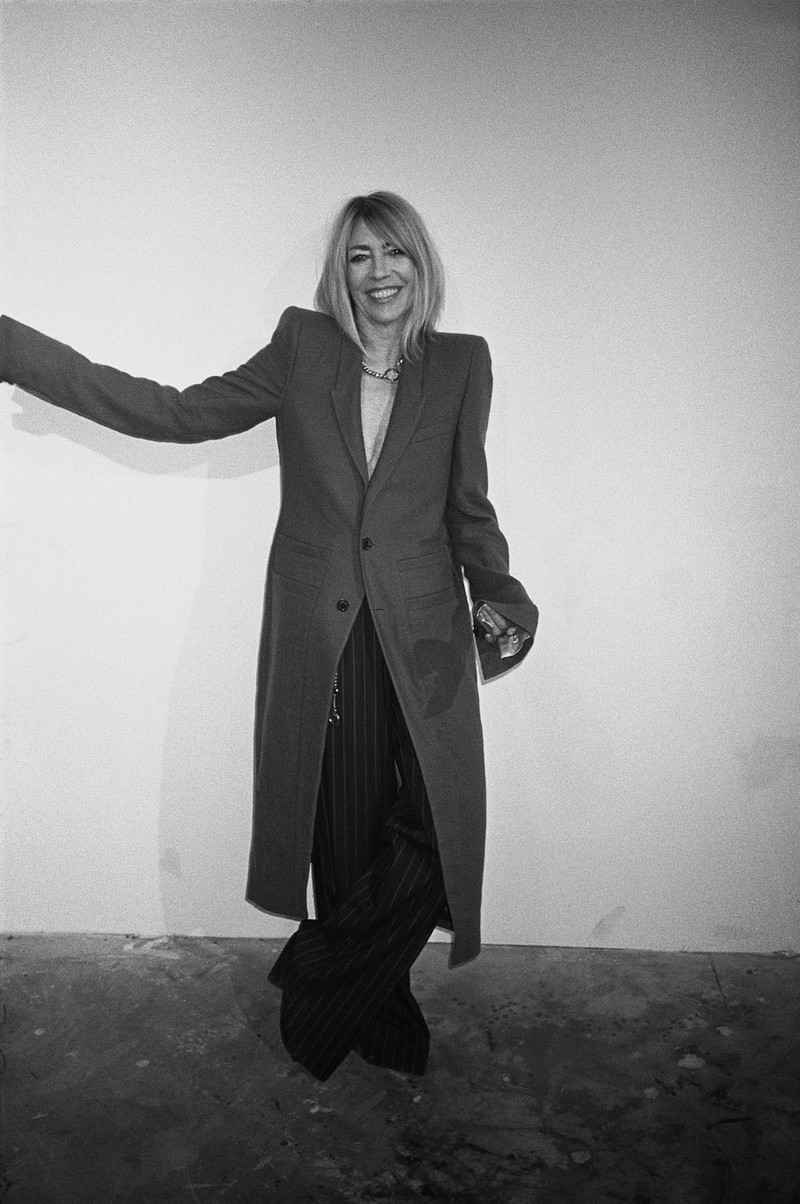
Coat: Rick Owens
Pants: Gucci
Gordon may be most closely tied to New York, but she spent much of her youth in Los Angeles. After her band dissolved, and her loft in TriBeCa and colonial in Northampton, Massachusetts, were packed up and sold, she headed back west to start over, purchasing a four-bedroom mullet-style home on a quiet street in the Franklin Hills neighborhood. She joins an ever-growing wave of NYC expats fleeing the city for the room-temperature sprawl of California’s cultural capital. When we meet Gordon at Matador’s office back in SoHo, it had been nearly four years since her move back to L.A.
“L.A. is harder to figure out,” Gordon says. “It’s more like a wide-ranging pastiche of people. It’s so spread out, [with] galleries hidden in weird places. There’s no locus that you can feel.”
The city’s DNA is woven into No Home Record. The first track, “Sketch Artist”, nods to the homeless crisis in L.A., which has garnered an increasingly fascist response from the local—and federal—government. But it also speaks to the duality that the city presents, with its glitzy facade and seedy underbelly. The album as a whole is a reflection of this concept—its package adorned with bright colors and images, yet its first notes aggressively harsh and dissonant.
Her legacy in music is such that it’s easy to overlook Gordon’s art practice, but she never set out to be a girl in a band; she moved to New York in 1980 to make visual art. She graduated from the Otis Art Institute in Los Angeles in 1977 (now the Otis College of Art and Design) and worked as an assistant for Annina Nosei and Larry Gagosian, before he became, well, Larry Gagosian. He would later exhibit her work. She palled around with Richard Prince, Julian Schnabel, Dan Graham, and Jeff Koons (who “pretty much no one liked,” she would later write). She developed a series called “Design Office” with a friend, doing exhibitions in people’s apartments “as interventions,” then writing about them for publications like Real Life and FILE, an experimental magazine from the art collective General Idea. The alternative nonprofit space White Columns first hosted work from “Design Office” in 1981—her first solo exhibit.
White Columns, which remains in operation in New York’s now-glitzy Meatpacking District, is one of the few surviving remnants of the downtown arts scene, and a pivotal space in Gordon’s story. It’s where a young Thurston Moore played his last show with his first band The Coachmen, the night he met Gordon. It marked the start of 30 years of collaboration—in Sonic Youth, in marriage, and in parenthood.
Gordon and Moore started Sonic Youth not long after they met. For Gordon, the life in music that followed was a happy accident. The New York art scene of the 1980s was flush with Wall Street cash and greed. Fat wallets fought over young artists, with experimentation often giving way to commerce. But the experimental music scene, still reverberating with the energy of the short-lived no wave scene, offered an escape: a less-commercial, freer way to express herself. “As we started,” she says, “we wanted to make something. This sounds pretentious, but we wanted to make something no one else had made.”
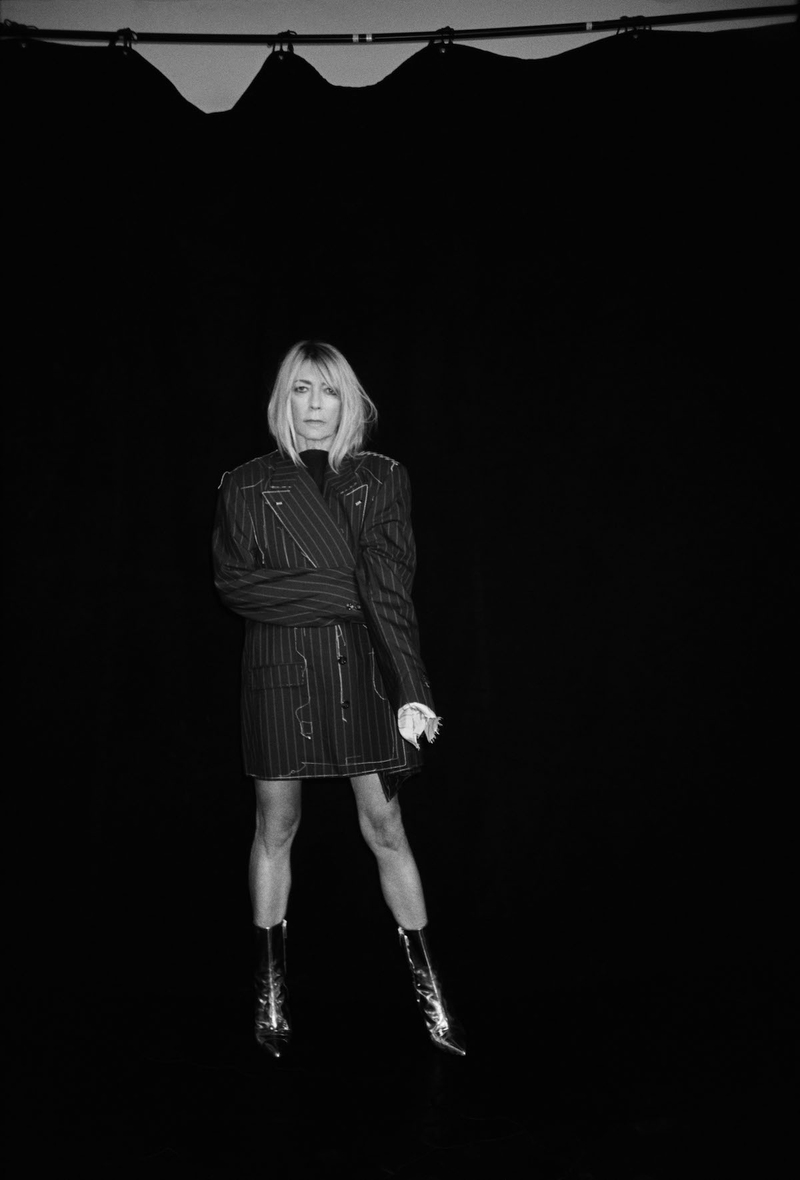
Bodysuit: Miu Miu at The Albright Fashion Library
Shoes: Balenciaga at The Albright Fashion Library
Their first records, Confusion is Sex and Kill Yr Idols in 1983, and EVOL two years later, were brash, dissonant, and intentionally confrontational. The Village Voice critic Robert Christgau was nearly set on fire at an early show.
Sonic Youth emerged from the embers of no wave, a scene embodied by the deconstruction of form, an emotive expression more concerned with provoking its audience than pleasing it. The brilliance of the band lay in its ability to imbue noise with youthful energy, experimenting with sonic textures and providing just enough rhythm to rock. By the time they released their major-label debut Goo in 1990, Gordon appeared mostly impervious to accusations of selling out that had been lobbied at most of the successful alternative rock acts of the era.
While they weren’t totally immune from criticism—their new label, DGC, was sued in the wake of sexual harassment allegations against one of its executives—the band never seemed to shy away from any of it. “That was kind of embarrassing,” she admits, “to have signed to a major label and have that happen.”
I don’t really care about the bass. I don’t really care about the guitar that much. It’s just a tool, and, I think, a symbol for something. It’s a symbol for taking some action and not being passive and making something.
Their next record, 1992’s Dirty, addressed it as directly as they ever have. “Don’t touch my breast/I’m just working at my desk/Don’t put me to the test/ I’m just doing my best,” Gordon growls on “Swimsuit Issue.” She may never have asked to be a feminist icon, but she sure as hell wasn’t avoiding it.
Gordon’s fashion palette serves as an extension of that projection of self-assuredness. Now well into her 60s, she still models for Ugg, Proenza Schouler, and Rodarte, to name a few. But back in the ‘80s and ‘90s, she pioneered a particular brand of thrift-store chic with the intention of 1960s British mod. In the early ‘90s she founded the streetwear brand X-Girl with the stylist Daisy von Furth as a sibling label to the menswear brand X-Large—run by the Beastie Boys’ Mike D, and others—and signing “It” girl of the moment Chloë Sevigny as its most famous face.
For a few years—X-Girl was sold to a Japanese company in 1998 and decamped to Tokyo—the label was a mecca for a certain downtown cool-girl, skater-adjacent look with a preppy twist. It was for girls who otherwise shopped at clothing-by-the-pound warehouses, cheap vintage stores, or the army navy places that lined Canal Street. The X-Girl store itself was a destination, a tiny spot on the coolest street of the Lower East Side before it came to Nolita. The clothes were cut small and straight but were emphatically not bodycon. Even the shift dresses and ‘70s-inspired baby tees were slightly androgynous. With its Mike-Mills-designed logo and reworking of deadstock pieces, X-Girl was firmly before its time.
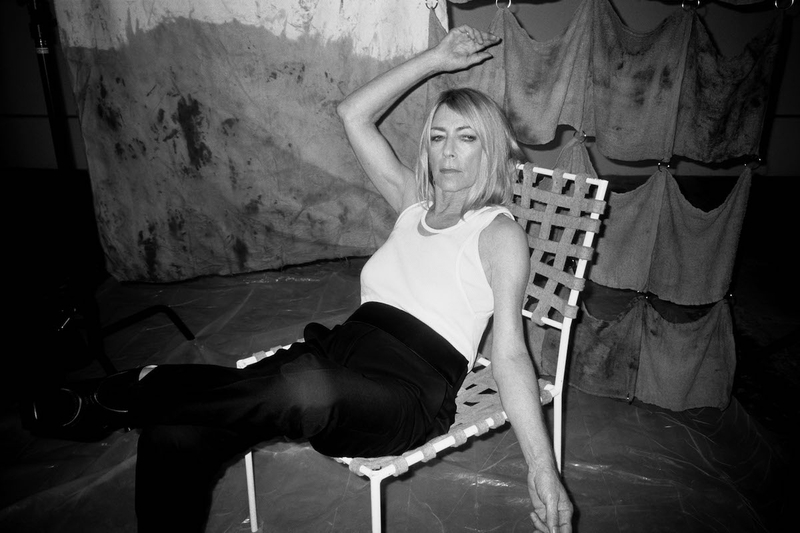
Top: Helmut Lang
Pants: Helmut Lang
Just as she did with her music, Gordon somehow managed to make even her most commercial moments punk as fuck. The brand’s first show in 1994 skipped the runway in favor of the streets of SoHo; Gordon and Von Furth’s friends Sofia Coppola and Spike Jonze used a concurrent Marc Jacobs show in the neighborhood to hijack foot traffic from Jacob’s show to their own.
Gordon and Moore’s breakup also broke up a band that never once felt dated in its 30 years of existence, and a family held up as proof that a rock star romance that lasts was not only possible, but desirable. She has moved on, but she often still struggles with that legacy, with fans, journalists, and critics intent on freezing a previous version of herself in amber, molding her experience into the significant moments of their own lives, inspiration for their own desires. If anything, she hopes to inspire action and self-actualization, whatever that might look like.
“I don’t relate to somebody who comes up to me who says, ‘Oh, you’re why I started playing the bass,’” she says. “‘Cause I don’t really care about the bass. I don’t really care about the guitar that much. It’s just a tool and, I think, a symbol for something. It’s a symbol for taking some action and not being passive and making something. It doesn’t matter whether you’re writing or playing an instrument. It doesn’t matter. But I never aspired to be a bass player in a band.”
I guess I realized people were actually very interested in me, and, I don’t know, I never really had that awareness. I had such a blind spot. so I’m just trying to be comfortable with stepping forward into the light.
Gordon doesn’t like to talk about Moore or Sonic Youth much these days. She has already laid her feelings bare in her 2015 memoir Girl in a Band. The book catalogues a life that vacillates between the ordinary and the extraordinary; a fraught family dynamic and suburban ennui punctuated by friendships and relationships with rock stars and rock star artists.
Girl in a Band pulls no punches. It opens at Sonic Youth’s last show in São Paulo, Brazil, a festival date with a massive crowd and a zombie crew that knew this was the end. She describes the intense loneliness she felt onstage, the magic of performing for thousands of screaming fans destroyed by her daughter’s father’s phony joviality. It’s a crushing scene, the death of an iconic rock band, the final chapter of an artistic marriage captured on video for all to see. But it also marked a new beginning.
The memoir was Gordon’s first real attempt at being a frontwoman. Sonic Youth may have seemed like a happy accident, but it was also a detour from an art career that centered her own voice first and foremost. From here on out, all eyes were on Kim.
“I’m just always trying to own up to what I’ve achieved in a certain way,” she says. “I don’t really think about what I’ve done that much except when people remind me, and I don’t know, I guess I feel like I need to be more responsible to that as far as who I am, and be comfortable with it.”
Girl in a Band was a way to move on, but also practically, a way to make money. Sonic Youth was her job, and when it ended, she was unemployed. She’d appeared on television shows like Gilmore Girls, Portlandia and Girls, and Gus Van Sant’s film Don’t Worry, He Won’t Get Far on Foot, but at the time, the band was her main source of income.
Gordon had gotten accustomed to evolving in someone else’s shadow from a young age, “whether it was my older brother, who was like a big personality,” or Moore, she says. “I always thought of him as like the kind of instigator in Sonic Youth and more of a front person in a way. And then when the band broke up, I guess I realized people were actually very interested in me, and, I don’t know, I never really had that awareness. I had such a blind spot. So I’m just trying to be comfortable with stepping forward into the light.”
Several years removed from that particular trauma and the yoke of being in one of the world’s most influential rock bands, Gordon is enjoying a new form of creative freedom. “I feel like this record is the most integrated of my art practice in music, in a way,” she says. That integration is evident on No Home Record, where the lines between her visual art practice and her music are often direct.
Airbnb plays a central role in both the album and She Bites Her Tender Mind, Gordon’s show at the Irish Museum of Modern Art (IMMA)—not so much the company but rather the construction of photographing a home for rent, both in optics and intent. “It’s kind of like this fantasy that you buy,” she says. Gordon admits to being “a little bit obsessed” with browsing listings, paying particular attention to the placement of art in the homes.
On the No Home Record track “Airbnb,” Gordon’s narrator is drunk with escapist pleasure: “It’s a good life/Oh yeah, delicious,” she sings, later wailing “Airbnb! Gonna set me free!” It’s a companion piece to her show at the IMMA, painting a picture with sounds and words of an “American idea” replete with blue towels and water bottles, slatted walls and a 47-inch flat screen. For the IMMA show, she created a series of four interconnecting rooms, complete with moldings, mantles and fireplaces, arranged like they would be in a home, with pieces she created adorning the walls. Several pieces feature text: “She,” “dead machines,” and “#Mood,” a wink at social media’s influence on the work. “I kind of was fantasizing as if it was like an Airbnb ... if I was to brand it in feminism, what would it look like? In some perverse way.”
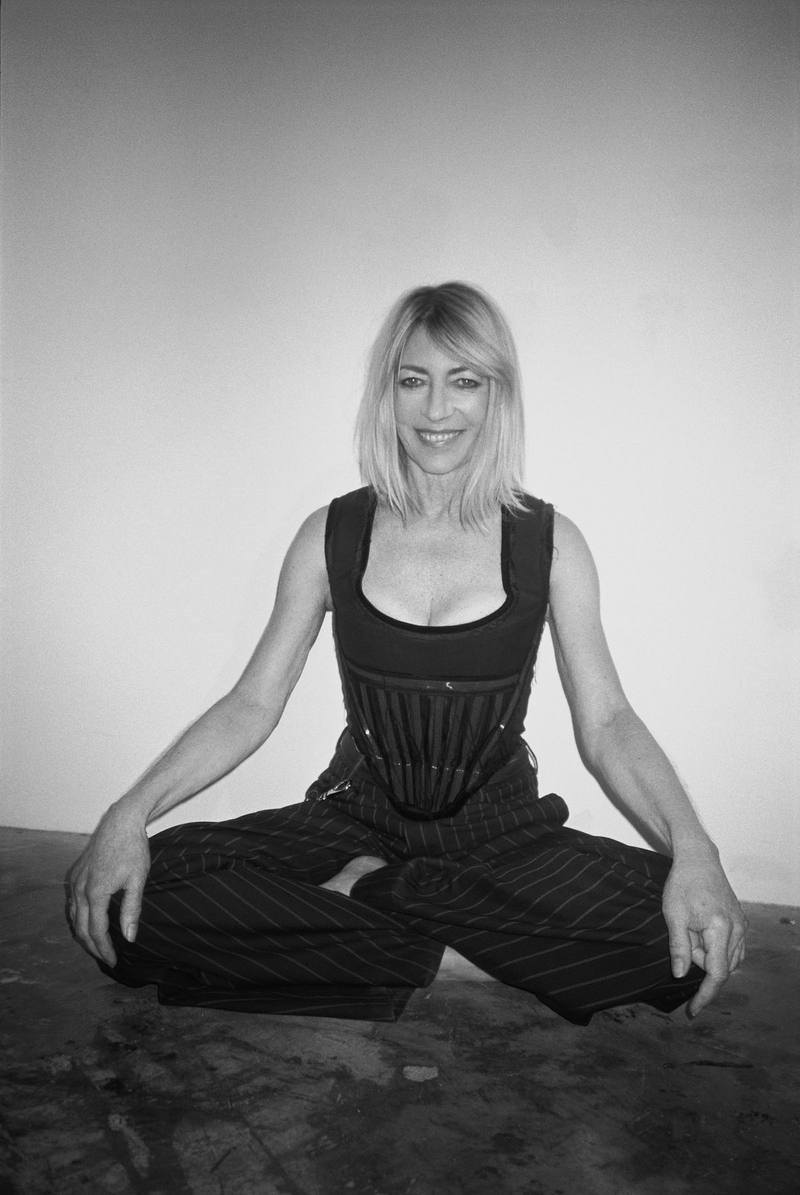
Pants: Gucci
The pieces of art in the Airbnb listings Gordon browses are there ostensibly for decoration, but they too communicate messages, sometimes a reflection of the owner, but usually driving home the fantasy; they’re a form of short-term real estate sloganeering. “It’s also this idea of, ‘Oh, I could start over here for a weekend.’ Like, be a different person ... but then the reality of the place, a lot of times, is not how it’s presented. Which is also interesting. Those are like little modern-day landscapes to me, those images that you see online.”
Even without the visual context, No Home Record is a stunning statement from an artist who has never seemed more sure of herself. She’s always been “cool,” by whatever arbitrary metric that’s measured, regardless of how less significant she may have felt at any given time or whatever sexist bullshit was being thrown her way. But this version of Kim Gordon—66 years old, single, with a grown daughter, Coco Gordon Moore, who’s an artist in her own right— is probably the coolest one yet. She still makes music that doesn’t sound like anyone else’s, because it couldn’t be made by anyone but her. Her voice is her own, and it never feels stale; it’s never standing still.
On Sonic Youth’s “Kool Thing,” arguably the most popular song on Goo, the band’s most popular record, Gordon sarcastically asks guest star Chuck D (of the rap group Public Enemy) if he’s going to “liberate us girls from male, white, corporate oppression.” Before she left us for the next stop on the No Home Record press tour, I asked her: After more than four decades of making art, has she wrestled back some of that control? Has she been able to liberate herself?
“Yeah, I guess so,” she says. “But ... I’m still figuring out who I am.”
